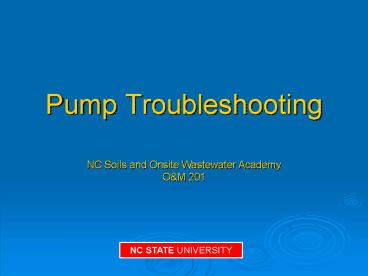Pump Troubleshooting - PowerPoint PPT Presentation
1 / 42
Title: Pump Troubleshooting
1
Pump Troubleshooting
- NC Soils and Onsite Wastewater AcademyOM 201
NC STATE UNIVERSITY
2
Pump Troubleshooting
- Quick overview of a pump and its internal parts
3
Internal Pump Components
4
Internal Pump Components
5
(No Transcript)
6
Useful tools for troubleshooting
- Multi-Meter
- OM Manuals
- Performance Curves
7
Useful Tools Multi-meter
8
Useful Tools OM Manuals
9
Useful Tools OM Manuals
10
Useful Tools Pump Performance Curve
11
Recommendations for Operation Maintenance
- Startup Reports Data Logging
- Periodic testing
- Key formulas, terms charts
12
Startup Reports Data Logging
13
Periodic Testing
- Performance Test on Pump
- Draw down test
- Amp reading
- Voltage reading during pump operation
- Ohm motor leads
- Compare data to initial startup/design
conditions
14
Periodic Testing
- Performance Test on Control Panel
- Voltage test
- Incoming Power
- Reading at terminal blocks to pump
- Confirm correct operation of automatic circuit
- Confirm proper operation of alarm circuit
- Verify timer settings if applicable
15
Periodic Testing
- Wet Well
- Pump out entire wet well to remove any debris,
solids build up or grease - Verify float elevations and compare to initial
installation - Verify that check valve is operating properly
16
Key Formulas and Terms
- Formulas
- Head 2.31 x Pressure Pressure Head x SP.
Gr. - SP. Gr.
2.31 - (SP. Gr. Specific Gravity (normally 1))
- (Head Total Dynamic Head)
17
Key Formulas and Terms
- Tank Volume
- Round Tank 3.14 x (r x r)
- 231 Gallons per inch
of water - (r radius of wet well in Inches)
- Square Tank L x W x 7.48052
- 12
Gallons per inch of water - (L Length)
- (W Width)
18
LOW PRESSURE PIPE (LPP) SYSTEMS
19
Typical LPP System
20
ENHANCED FLOW STEP SYSTEMS
21
Typical Enhanced Flow Sep System
22
(No Transcript)
23
(No Transcript)
24
(No Transcript)
25
Velocity Head Loss Chart
26
Troubleshooting
- Identifying the problem
- Identifying the cause
- Correcting the problem
27
The following slides follow the SSPMA
Troubleshooting Guidelines
- The format of the Guide is
- What is the problem
- List of potential cause followed by
- Specific test to see if the cause suggested is
the true cause - Potential solution
28
Examples
29
Identify symptom
- TROUBLE SYMPTOM CAUSE-TEST-CURE
- PUMP FAILS TO OPERATE 1-A-1 5-E- 7 26- K-13
- (Motor does not run) 1-A-2 5-E- 8 27- T-13
- 2-B- 4 6-H-13 28- K-13
-
2-B- 5 6-H-31 29- P-13 -
2-B- 7 7-H-31 31- J- 9
2-C- 4 9-E- 6 31- J-31 -
2-C- 5 9-E- 7 40- Z-32 -
3-H- 4 9-E- 8 41-AA-33 -
3-H- 5 10-J- 9 42- P-34 -
3-H- 7 10-J-31 42- P-35 -
4-E- 6 14-J-10 42- P-36
4-E- 7 14-J-11 42- P-37 -
5-D-3 14-J-31 43- P-38 -
5-D- 6 16-L-27 44- P-39 -
5-D-31 16-S-27 45- Z-40
5-E-
6 16-Y-27 45- Z-41
30
The Pump Fails to Operate
- Why?
- Not plugged in
- Circuit not connected
- Circuit breaker blown
- Wiring inadequate
- Pump overload tripped
- Float defective
- etc.
31
The Pump Fails to Operate
- Because (test)
- Check pump cord for tightness or corrosion
- Test for power
- Check fuses and breakers
- etc.
32
The Pump Fails to Operate
- Correction (solution)
- Replace plug or clean plugs prongs with abrasive
paper - Replace electrical receptacle
- Replace fuse with slow-blow fuse
- etc.
33
The pump sounds like a freight train
- so, you go to the site and
What do you do?
34
POSSIBLE CAUSE OF PROBLEM
- 11. Impeller loose on shaft.
- 13. Impeller rubbing inlet plate or pump housing.
- 15. Worn out or defective pump or motor bearings.
- 30. Loose shaft coupling.
- 31. Obstructed rotating parts.
- 35. Discharge plumbing connected directly to
floor joists. - 36. Pump not positioned firmly on bottom of sump.
- 37. Gravel or stones on bottom of sump.
35
TEST
- F. Disconnect power and check pump for stability.
(36) - J. Disconnect power, remove pump from sump and
observe for freedom of impeller and shaft
rotation. (11, 13, 30, 31) - 0. Evacuate sump. (37)
- P. Examine and observe. (15, 35)
36
CORRECTION(S)
- 9. Clean volute and impeller and remove any
blockage. (31) - 11. Replace pump bearing. (15)
- 22. Tighten coupling and set screws. (30)
- 23. Tighten fasteners, replace key. (11)
- 28. Readjust discharge piping and pump.
- (35, 36)
- 29. Replace portion of discharge with rubber
hose. (35) - 30. Clean sump. (37)
- 31. Return pump to Authorized Service Center.
(13)
37
The pump turns on and off constantly
- so, you go to the site and
What do you do?
38
POSSIBLE CAUSE OF PROBLEM
17. Water inflow excessive 23. Defective or
inoperative check valve. 25. No check valve in
high head installations. 28. Floats or weights
improperly adjusted. 34. Sump size too small.
39
TEST
- K. Add water to sump and observe turn-on. (28)
- M. Measure sump depth and width and compare to
specs. (34) - P. Examine and observe. (25)
- R. Observe backflow of water from discharge. (23)
- S. Observe source and amount of water inrush.
(17) - V. Check gate of check valve. (23)
40
CORRECTION(S)
- 12. Have larger sump and pump installed. (17)
- 13. Readjust control floats or weights. (28)
- 19. Install larger sump. (34)
- 24. Install check valve. (25)
- 25. Clean gate or check valve. (23)
41
- Helpful Websites
- www.sspma.org
- www.swpa.org
42
Another Example
- What is a problem you have seen with a pump?































